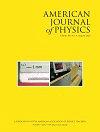从吸虫到 Windkessel:十八世纪早期灭火装置的物理学原理
IF 0.8
4区 教育学
Q3 EDUCATION, SCIENTIFIC DISCIPLINES
引用次数: 0
摘要
我们描述了 "温德凯瑟尔效应 "的物理原理,以及它在平滑早期消防车和现代住宅水井房中的活塞驱动水泵所产生的出水量方面的作用。我们还构建了一个简单的运行分析模型,并将该模型应用于理查德-纽沙姆 1725 年消防车中的 Windkessel。我们发现纽沙姆的 Windkessel 可以将水泵输出水流的变化从最高的 80% 降低到最低的 16%。本文章由计算机程序翻译,如有差异,请以英文原文为准。
From sucking worms to Windkessel: The physics of an early eighteenth century firefighting device
We describe the physics of the “Windkessel effect” and its role in smoothing the output of water produced by piston-driven pumps found in early fire engines and modern residential well houses. We also construct a simple, analytical model of its operation and apply this model to the Windkessel in Richard Newsham's 1725 fire engine. We find that Newsham's Windkessel reduces the variations in the pump output stream from a high of 80% to a low of 16%.
求助全文
通过发布文献求助,成功后即可免费获取论文全文。
去求助
来源期刊

American Journal of Physics
物理-物理:综合
CiteScore
1.80
自引率
11.10%
发文量
146
审稿时长
3 months
期刊介绍:
The mission of the American Journal of Physics (AJP) is to publish articles on the educational and cultural aspects of physics that are useful, interesting, and accessible to a diverse audience of physics students, educators, and researchers. Our audience generally reads outside their specialties to broaden their understanding of physics and to expand and enhance their pedagogical toolkits at the undergraduate and graduate levels.
 求助内容:
求助内容: 应助结果提醒方式:
应助结果提醒方式:


